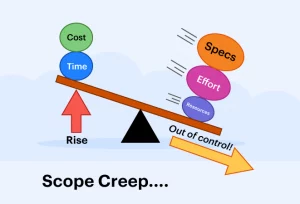The Best Practices to Avoid Scope Creep

Ever tried making an omelet? It’s the same as a project.
The desired result is to have a fluffy omelet in 10 minutes. That is what the project scope is. It’s a 2-egg omelet that is fluffy and has just the right amount of spices in 10 minutes or under.
Ever messed up the omelet because you decided to add too many spices in the end, or decided to give it a whirl when the contents were already in the pan? That is how you end up making scrambled eggs instead. And that is scope creep.
How to avoid it – Keep the end in mind. Always prioritize. Your actions should be focused on making the omelet first, within the required timeframe. The rest comes later.
That’s it, Scope creep in the simplest of terms. Why take an example from cooking? Because Scope Creep is also called Kitchen Sink syndrome. But let’s dig into it deeper.
Definition of Scope Creep-
A project can be defined in many different ways. But simply put, the project is the work done with the intention of achieving the desired result. And the scope of a project defines the successful deliverable for the project. A working website to sell pots, software to generate QR codes, or a piece of a blog to let people know about scope creep.
Scope creep is when we move away from the desired end product because we changed the scope too much. It may not have the same attributes as desired, was too costly, or was delivered too late. Like a website that could have been built in 1 month but took 2 instead because you decided to add an animation where the plant grows from a bud into a groot. Or a QR code generator which costs $5000 because someone suggested that not only should it generate the QR code, but also write a poem describing the QR using a Machine Learning Model.
In fact, if you look up the word creep on the internet, it is defined as the verb ‘to move very quietly and carefully so that nobody will notice you. When you add this to the word ‘Scope’, it becomes a noun and a verb at the same time. A scope creep is when the scope of the project is changed such that we do not notice it until some damage has been done and the damage is unpleasant.
Wikipedia defines it as ‘changes, continuous or uncontrolled growth in a project’s scope, at any point after the project begins. This can occur when the scope of a project is not properly defined, documented, or controlled. It is generally considered harmful.’
What causes scope creep?
That definition pretty much covers the major reasons-
- Scope not correctly defined
- Scope not documented
- Scope not controlled or monitored
Another major reason is a lack of communication and miscommunication. And sometimes unmanaged communication.
There are numerous reasons for scope creep. But it can be simplified into 2 major zones-
- Lack of clarity on what is the scope of the project – Be very clear on what your software should look like and how it should behave. Having Wireframes and Mockups in the early stages of the project helps a lot. And all those hours that you spent on analyzing the requirement, it is so that you have a clear vision of what is being built and what will constitute the final product.
- Inability to communicate the scope to the whole team – Once you have the scope defined, it is time to communicate the same to the team. Everyone involved should understand what needs to be done, and what contribution is expected of them. A project is a team effort and a winning team always communicates clearly.
How to avoid it?
Warren Buffet was once asked at a dinner party about the secret of his success. He replied with a single word, “Focus”. Another giant was at the same party and he corroborated Warren’s claim. That man was Bill Gates.
Focus is the key to managing the project scope- maintain focus on what is the final product and keep monitoring if you are moving in the right direction. It’s not much different from driving a car. If a successful project is to reach your destination in time, then you only need to keep your car on track. If you notice that you are off track, steer in the right direction.
Managing the scope of your project is a delicate business. You cannot shoot down the necessary requirements which will help your project (Scope Kill) but you cannot let the changes run amock leading to Scope Drift. It needs a little practice and some experience and a little vigilance and you will find your balance.

How can Rubico Help You- Our Tactics to avoid Scope Creep?
We, at Rubico, specialize in building customized software and websites. We have a very experienced team of developers and project coordinators to ensure that a successful project is delivered to you. And we have an Agile way of working.
Some of the practices we follow to ensure that scope doesn’t happen are listed under
- Clarity of the scope – We ensure that the requirements are very clearly defined through rigorous meetings and discussions. We have a consultative approach so that our experiences can help our clients make better decisions. We document these to lay out the scope of the project.
- Milestones not set– As we define the scope, we lay out the plan to move toward that goal. We break it down into Sprints with well-defined milestones. This ensures we are always on track or can redirect if we are a bit adrift.
- Manage the Scope and Change requirements– Changes are a necessity and we accept the incorporation of the project. The important thing is to analyze the risk that these changes present and keep track of them so the Scope is not disturbed in an undesirable way.
- Keep track of requirements– All changes are monitored and incorporated into sprints to ensure that the milestones are met on time and within budget. Minor changes are controlled so that they do not harm the timeline and the budget of the project.
- Facilitate and ensure correct communication– Daily Standups and Weekly client meetings are a definite part of our culture. It ensures that we do not miss any important detail and all members are fully informed of the project’s progress. We use emails, collaborative documents, and project management tools like Trello to ensure that everything is recorded and accessible to all. We have developed checklists and template documents to help achieve success.
- Transparency– Every tool that we work on is colligative and accessible to all. That includes our documents, the breakdown of the hours we spent working, everything. Transparency is the foundation on which we build trust and rapport with our clients.
These are the steps that you can follow in your own project as well.
Goals of projects
The ultimate goal is project success and to simplify, it is very much like driving a car. Make sure you know where you are going, set milestones to know you are on the right path, monitor your progress to make sure you are in the right direction and steer the wheel if you ever notice that you are not going the right way.
Nate Nishant, a project coordinator wrote this article. He has been working at Rubico for the last 8 months on multiple high-priority projects. For more information, head over to his LinkedIn.
With offices in the United States and India, Rubico is passionate about building websites, web applications, and mobile apps. With over 200 professionals and decades of experience, Rubico is dedicated to providing high-quality custom programming software development within the latest technologies.









